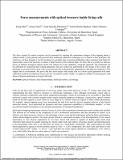Force measurements with optical tweezers inside living cells
Abstract
The force exerted by optical tweezers can be measured by tracking the momentum changes of the trapping beam, a method which is more general and powerful than traditional calibration techniques as it is based on first principles, but which has not been brought to its full potential yet, probably due to practical difficulties when combined with high-NA optical traps, such as the necessity to capture a large fraction of the scattered light. We show that it is possible to measure forces on arbitrary biological objects inside cells without an in situ calibration, using this approach. The instrument can be calibrated by measuring three scaling parameters that are exclusively determined by the design of the system, thus obtaining a conversion factor from volts to piconewtons that is theoretically independent of the physical properties of the sample and its environment. We prove that this factor keeps valid inside cells as it shows good agreement with other calibration methods developed in recent years for viscoelastic media. Finally, we apply the method to measuring the stall forces of kinesin and dynein in living A549 cells.
Citation
Mas , J , Farre , A , Sancho-Parramon , J , Martin-Badosa , E & Montes-Usategui , M 2014 , Force measurements with optical tweezers inside living cells . in K D Gabriel C. Spalding (ed.) , Optical Trapping and Optical Micromanipulation XI . vol. 9164 , Proceedings of SPIE , vol. 9164 , SPIE . https://doi.org/10.1117/12.2061919
Publication
Optical Trapping and Optical Micromanipulation XI
ISSN
0277-786XType
Conference item
Rights
Copyright 2014 Society of Photo Optical Instrumentation Engineers. One print or electronic copy may be made for personal use only. Systematic reproduction and distribution, duplication of any material in this paper for a fee or for commercial purposes, or modification of the content of the paper are prohibited. Originally published here: http://dx.doi.org/10.1117/12.2061919
Items in the St Andrews Research Repository are protected by copyright, with all rights reserved, unless otherwise indicated.

